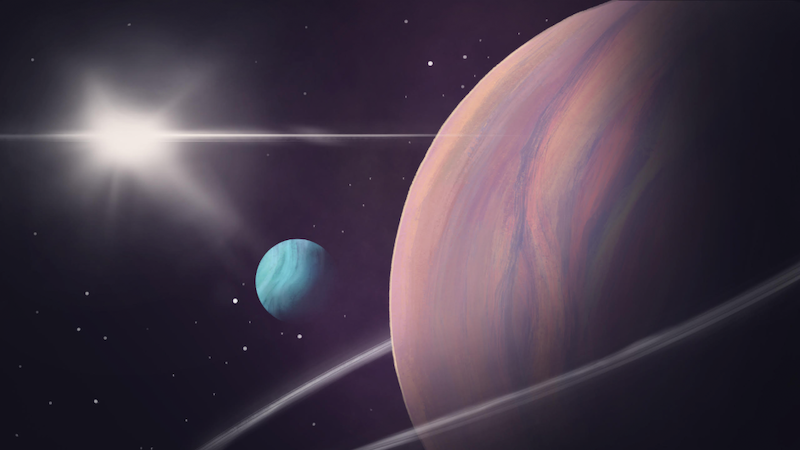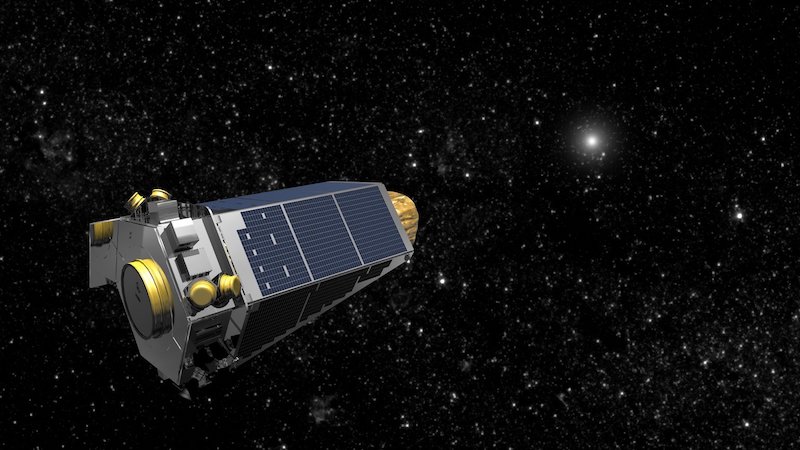
Moons are common in our solar system. In fact, there are over 200 known moons altogether in our sun’s family. And what about in other solar systems? It makes sense to think that moons of planets are widespread throughout our galaxy and beyond. But these exomoons – moons beyond our solar system – are difficult to detect. They’re even harder than distant planets. And we know only just over 4,000 exoplanets of the billions of planets that likely orbit stars in our Milky Way galaxy. And yet there’ve been a few possible detections of exomoons – typically much larger than any moons in our solar system – albeit not with 100% certainty yet. This month (January 13, 2022), researchers at Columbia University in New York said they’ve tentatively identified another new exomoon candidate. It’s orbiting a distant exoplanet over 5,000 light-years away.
The researchers published the details of the exomoon candidate, called Kepler-1708 b-i, in a new peer-reviewed paper in the journal Nature Astronomy on January 13, 2022. It was identified in data from the now-completed Kepler Space Telescope mission.
EarthSky 2022 lunar calendars now available! Order now. Going fast!
New exomoon candidate: Kepler-1708 b-i
David Kipping and his Cool Worlds Lab at Columbia University led the team that made the discovery. He commented on how it is difficult to find exomoons, saying:
Astronomers have found more than 10,000 exoplanet candidates so far, but exomoons are far more challenging. They are terra incognita.
The possible exomoon – still a candidate at this point – orbits the giant planet Kepler 1708b. This planet is just slightly smaller than Jupiter but 4.6 times as massive. It orbits its sunlike star, 5,436 light-years from Earth, in about two years. As would be expected, larger moons are easier to detect compared to smaller ones. Kipping said:
The first detections in any survey will generally be the weirdos. The big ones that are simply easiest to detect with our limited sensitivity.
Cold, gas giant planets
The new candidate exomoon was found while the researchers were studying 70 cold, gas giant planets. Like Jupiter and Saturn, they orbit far from their stars. At those distances, there is less gravity from the stars to tug at any moons and remove them from their orbits. They only found one signal of a possible exomoon, but it’s a good one. As Kipping noted:
It’s a stubborn signal. We threw the kitchen sink at this thing but it just won’t go away.

If planets like Jupiter, Saturn, Uranus and Neptune are any indication, then it seems reasonable that other giant planets should have moons as well, maybe even dozens, just like in our own solar system. We don’t have any moons the size of these new candidates, but if there are big moons out there, then there should be smaller ones as well.
Some skepticism
The news has been met with skepticism from some scientists, as might be expected. As Eric Agol at University of Washington stated:
It might just be a fluctuation in the data, either due to the star or instrumental noise.
Astronomer Michael Hippke in Germany countered that, however, saying:
We find an intriguing object, make a prediction, and either confirm the exomoon candidate or rule it out with future observations. I am very excited to see a second exomoon candidate, although it is unfortunate that only two transits have been observed. More data would be very cool.
Confirming the first exomoons would be – or should we say will be – exciting, to say the least. The first reported possible exoplanets, starting in 1992, were also met with skepticism. Today, we know of nearly 5,000 confirmed such worlds, with many more candidates as well. As Kipping noted:
Those planets are alien compared to our home system. But they have revolutionized our understanding of how planetary systems form.
New exomoon candidate is just the latest
There have been a few other candidate exomoons so far as well. One of them may be orbiting a similar Jupiter-sized exoplanet called Kepler 1625b. Its potential discovery was announced in 2018. Like Kepler-1708 b-i, it also orbits far away from its star. Kepler 1625b is about 8,000 light-years from Earth. If it is a real moon, it is huge, about the size of Neptune! The data for this possible moon came from both Kepler and the Hubble Space Telescope.

Back in 2014, astronomers announced a possible moon orbiting a rogue planet known as MOA-2011-BLG-262L . It was tentatively identified using the microlensing technique. In this case, however, it is still possible that the planet is actually a red dwarf star, and the moon is a planet.
In 2020, astronomers discovered what may be no less than six more exomoons orbiting exoplanets ranging from 200 to 3,000 light-years away.
Bottom line: Astronomers announced a new exomoon candidate orbiting an exoplanet about 5,400 light-years from Earth. Detected in data from the Kepler Space Telescope, it is the latest possible exomoon found so far.
Source: An exomoon survey of 70 cool giant exoplanets and the new candidate Kepler-1708 b-i
The post New exomoon candidate discovered: Is it real? first appeared on EarthSky.
from EarthSky https://ift.tt/3nWdgHV

Moons are common in our solar system. In fact, there are over 200 known moons altogether in our sun’s family. And what about in other solar systems? It makes sense to think that moons of planets are widespread throughout our galaxy and beyond. But these exomoons – moons beyond our solar system – are difficult to detect. They’re even harder than distant planets. And we know only just over 4,000 exoplanets of the billions of planets that likely orbit stars in our Milky Way galaxy. And yet there’ve been a few possible detections of exomoons – typically much larger than any moons in our solar system – albeit not with 100% certainty yet. This month (January 13, 2022), researchers at Columbia University in New York said they’ve tentatively identified another new exomoon candidate. It’s orbiting a distant exoplanet over 5,000 light-years away.
The researchers published the details of the exomoon candidate, called Kepler-1708 b-i, in a new peer-reviewed paper in the journal Nature Astronomy on January 13, 2022. It was identified in data from the now-completed Kepler Space Telescope mission.
EarthSky 2022 lunar calendars now available! Order now. Going fast!
New exomoon candidate: Kepler-1708 b-i
David Kipping and his Cool Worlds Lab at Columbia University led the team that made the discovery. He commented on how it is difficult to find exomoons, saying:
Astronomers have found more than 10,000 exoplanet candidates so far, but exomoons are far more challenging. They are terra incognita.
The possible exomoon – still a candidate at this point – orbits the giant planet Kepler 1708b. This planet is just slightly smaller than Jupiter but 4.6 times as massive. It orbits its sunlike star, 5,436 light-years from Earth, in about two years. As would be expected, larger moons are easier to detect compared to smaller ones. Kipping said:
The first detections in any survey will generally be the weirdos. The big ones that are simply easiest to detect with our limited sensitivity.
Cold, gas giant planets
The new candidate exomoon was found while the researchers were studying 70 cold, gas giant planets. Like Jupiter and Saturn, they orbit far from their stars. At those distances, there is less gravity from the stars to tug at any moons and remove them from their orbits. They only found one signal of a possible exomoon, but it’s a good one. As Kipping noted:
It’s a stubborn signal. We threw the kitchen sink at this thing but it just won’t go away.

If planets like Jupiter, Saturn, Uranus and Neptune are any indication, then it seems reasonable that other giant planets should have moons as well, maybe even dozens, just like in our own solar system. We don’t have any moons the size of these new candidates, but if there are big moons out there, then there should be smaller ones as well.
Some skepticism
The news has been met with skepticism from some scientists, as might be expected. As Eric Agol at University of Washington stated:
It might just be a fluctuation in the data, either due to the star or instrumental noise.
Astronomer Michael Hippke in Germany countered that, however, saying:
We find an intriguing object, make a prediction, and either confirm the exomoon candidate or rule it out with future observations. I am very excited to see a second exomoon candidate, although it is unfortunate that only two transits have been observed. More data would be very cool.
Confirming the first exomoons would be – or should we say will be – exciting, to say the least. The first reported possible exoplanets, starting in 1992, were also met with skepticism. Today, we know of nearly 5,000 confirmed such worlds, with many more candidates as well. As Kipping noted:
Those planets are alien compared to our home system. But they have revolutionized our understanding of how planetary systems form.
New exomoon candidate is just the latest
There have been a few other candidate exomoons so far as well. One of them may be orbiting a similar Jupiter-sized exoplanet called Kepler 1625b. Its potential discovery was announced in 2018. Like Kepler-1708 b-i, it also orbits far away from its star. Kepler 1625b is about 8,000 light-years from Earth. If it is a real moon, it is huge, about the size of Neptune! The data for this possible moon came from both Kepler and the Hubble Space Telescope.

Back in 2014, astronomers announced a possible moon orbiting a rogue planet known as MOA-2011-BLG-262L . It was tentatively identified using the microlensing technique. In this case, however, it is still possible that the planet is actually a red dwarf star, and the moon is a planet.
In 2020, astronomers discovered what may be no less than six more exomoons orbiting exoplanets ranging from 200 to 3,000 light-years away.
Bottom line: Astronomers announced a new exomoon candidate orbiting an exoplanet about 5,400 light-years from Earth. Detected in data from the Kepler Space Telescope, it is the latest possible exomoon found so far.
Source: An exomoon survey of 70 cool giant exoplanets and the new candidate Kepler-1708 b-i
The post New exomoon candidate discovered: Is it real? first appeared on EarthSky.
from EarthSky https://ift.tt/3nWdgHV

Aucun commentaire:
Enregistrer un commentaire